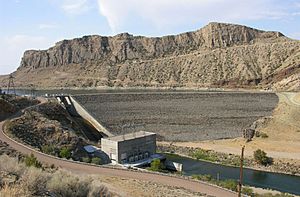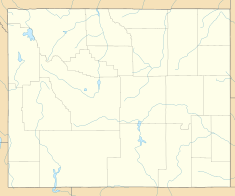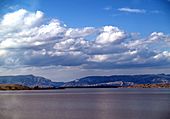Boysen Dam facts for kids
Quick facts for kids Boysen Dam |
|
|---|---|

Boysen Dam in 2012
|
|
|
Location of Boysen Dam in the state of Wyoming.
|
|
| Country | United States |
| Location | Fremont County, Wyoming |
| Coordinates | 43°25′02″N 108°10′39″W / 43.41722°N 108.17750°W |
| Status | In use |
| Construction began | 1947 |
| Opening date | 1952 |
| Construction cost | $18.5 million |
| Owner(s) | U.S. Bureau of Reclamation |
| Dam and spillways | |
| Type of dam | Rockfill |
| Impounds | Wind River |
| Height | 220 ft (67 m) |
| Length | 1,143 ft (348 m) |
| Elevation at crest | 4,758 ft (1,450 m) |
| Width (crest) | 30 ft (9.1 m) |
| Width (base) | 919 ft (280 m) |
| Dam volume | 1,527,386 cu yd (1,167,770 m3) |
| Spillways | 2 |
| Spillway type | Concrete chute and river outlets |
| Spillway capacity | 26,300 cu ft/s (740 m3/s) |
| Reservoir | |
| Creates | Boysen Reservoir |
| Total capacity | 952,400 acre⋅ft (1,174,800 dam3) |
| Active capacity | 802,000 acre⋅ft (989,000 dam3) |
| Inactive capacity | 150,400 acre⋅ft (185,500 dam3) |
| Catchment area | 7,700 sq mi (20,000 km2) |
| Surface area | 19,560 acres (7,920 ha) |
| Maximum water depth | 117 ft (36 m) |
| Normal elevation | 4,732 ft (1,442 m) (max) |
| Power station | |
| Turbines | 2 |
| Installed capacity | 15 MW |
| Annual generation | 37,856,600 KWh |
The Boysen Dam is a large rockfill dam in the U.S. state of Wyoming. It sits on the Wind River at the start of the Wind River Canyon. This dam creates the Boysen Reservoir. The U.S. Bureau of Reclamation owns it. The dam helps provide water for farming in the Bighorn Basin. It also helps control floods and makes electricity.
History of Boysen Dam
The very first dam at this spot was built in 1908. A man named Asmus Boysen oversaw its construction. This small concrete dam made 710 kilowatts of electricity. It was located just downstream from where the current dam is. By 1925, the old dam had filled up with dirt and was removed in 1948.
The Bureau of Reclamation started looking into building a new dam here as early as 1904. However, a final plan wasn't ready until 1942. At first, the U.S. Army Corps of Engineers suggested building the new Boysen Dam right where the old one was. But they later decided to move the new dam about 1.5 miles (2.4 km) upstream. This change helped to lower the building costs.
Building the Dam
Work on the Boysen Dam began on September 9, 1946. First, they had to set up government buildings, a camp for workers, and storage areas. They also installed power lines. A big part of the early work was moving U.S. Highway 20 and the Chicago, Burlington and Quincy Railway. These needed to go around the construction site.
The main contract for building the dam went to the Morrison-Knudsen Company for $13.9 million. Most of the early work, like digging the foundations and setting up the camp, was done by late 1947. The official groundbreaking ceremony happened on September 19, 1947.
In February 1948, they started digging a tunnel to divert the river. Work also continued on moving the railway. The train tracks would actually run under the dam and parts of the future reservoir. This required building a long tunnel, about 7,131 feet (2,174 m) long.
By March 1949, the river diversion tunnel was finished. The railway relocation was also mostly done, even with some small problems like a rockslide. On December 23, 1949, a temporary dam, called a cofferdam, was completed across the Wind River. This made the river flow through the new diversion tunnel. This allowed workers to build the main part of the dam.
As the dam's main structure grew taller, the train tunnel was finished. It opened on September 5, 1950. After that, work began on the dam's power plant. They also started clearing the area where the reservoir would be, which cost about $637,000.
Building the powerhouse continued through 1951. Equipment for the dam started arriving in July of that year. The generators and other machinery cost $604,501. The main part of the dam was finished a month later. On October 11, 1951, the diversion tunnel was sealed, and the Boysen Reservoir began to fill up. The powerhouse was completed in December 1951. The entire dam project was finished on February 16, 1952, costing $18,576,405 in total. The dam officially started working on December 11, 1952.
What the Dam Does
Boysen Dam is made of earth and rock. It stands 220 feet (67 m) high from its base and is 1,143 feet (348 m) long. The dam creates a reservoir that can hold 952,400 acre-feet (1.175 km³) of water. A large part of this water, 520,679 acre-feet (0.642 km³), is kept for flood control each year. Another 144,229 acre-feet (0.178 km³) is used for farming and for cities. The dam provides electricity to different parts of Wyoming, from Alcova to Thermopolis.
The dam is also very important for controlling floods. Since it was built until 1998, it has prevented about $75 million in flood damages. The dam has a special concrete overflow structure called a spillway. It is controlled by two radial gates and can release 25,000 cubic feet per second (708 m³/s) of water.
Images for kids




